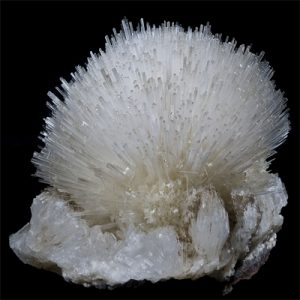Natrolite
Natrolite is one of the more popular and well-known members of the Zeolite Group of minerals that includes over 40 minerals and these gem-type minerals: Analcime, Barrerite, Chabazite, Epistilbite, Gmelinite-Na, Goosecreekite, Mordenite, Natrolite, Pollucite, Scolecite, Stellerite, Stilbite, Thomsonite and Yugawaralite. Natrolite usually forms as elongated crystals so faceted gems are often cut as elongated emerald cut gems. Natrolite gems are colorless and have weak dispersion and might be considered somewhat uninteresting except for the fact that Natrolite is both piezoelectric and pyroelectric and commonly exhibits yellow to orange or pale green fluorescence under both shortwave and longwave UV light.
Natrolite was discovered in 1803 at Hohentwiel, Singen, Hegau, Baden-Württemberg, Germany. Hohentwiel is an extinct volcano. Natrolite was named by German chemist Martin Heinrich Klaproth (1743-1817) from the Latin word natron meaning soda, for its sodium content, and the Greek word λίθος, (lithos) meaning stone.
Crystals can be found in many locations worldwide but gem quality crystals are relatively rare. Notable occurrences are the Höwenegg quarry, Hegau, Baden-Württemberg, Germany (the Type Locality); Puy de Marman, near Veyre, Puy-de-Dôme, France. In the Dean quarry, St. Keverne, Lizard Peninsula, Cornwall, England; White Head, County Antrim, Ireland; Langesundsfjord and Tvedalen areas, Norway; Khibiny and Lovozero massifs, Kola Peninsula, Russia (large crystals); in the USA, at Bound Brook, Somerset County, New Jersey; from north of Livingstone, Park County, Montana; around Springfield, Lane County, Oregon; and at the Gem mine, San Benito County, California, USA. In Canada, huge crystals from the Johnston asbestos mine, near Thetford, and from Mont Saint-Hilaire, Quebec; in the Bay of Fundy district, Nova Scotia; and along the Ice River, British Columbia.
| Category: | Tectosilicate |
| Chemical Formula: | Na2Al2Si3O10 • 2H2O |
| Hydrated Sodium Aluminum Silicate | |
| Molecular Weight: | 380.22 gm |
| Composition: | Sodium | 12.09 % | Na | 16.30 % | Na2O |
| Aluminum | 14.19 % | Al | 26.82 % | Al2O3 | |
| Silicon | 22.16 % | Si | 47.41 % | SiO2 | |
| Hydrogen | 1.06 % | H | 9.48 % | H2O | |
| Oxygen | 50.49 % | O | |||
| 100.00 % | 100.00 % | = TOTAL OXIDE |
| Crystallography: | Orthorhombic – Pyramidal |
| Crystal Habit: | Crystals short to long prismatic, to 1 m, striated. In stellate or interlacing groups; also radiating fibrous, granular, or compact, massive. |
| Twinning: | On {110}, {011}, {031} |
| Cleavage: | Perfect on {110}, parting on {010} |
| Fracture: | Irregular/uneven |
| Tenacity: | Brittle |
| Moh’s Hardness: | 5.5 – 6.0; Vickers: VHN200=1239 – 1467 kg/mm2 |
| Density: | 2.20 – 2.26 (g/cm3) |
| Luminescence: | Fluorescent; SW UV = yellow-orange, pale green, LW UV = yellow-orange, greenish white |
| Radioactivity: | Not Radioactive |
| Other: | Piezoelectric and Pyroelectric |


